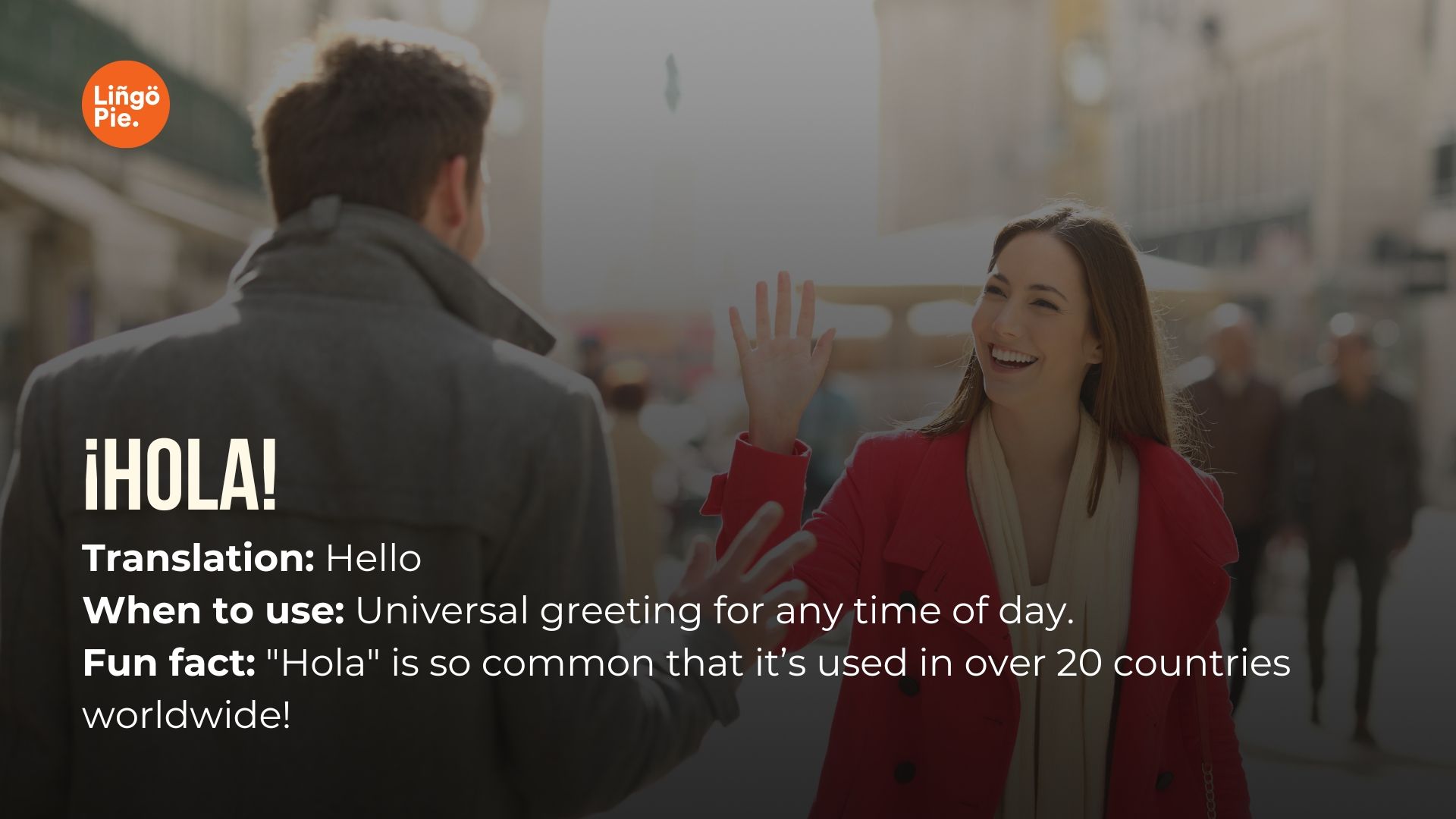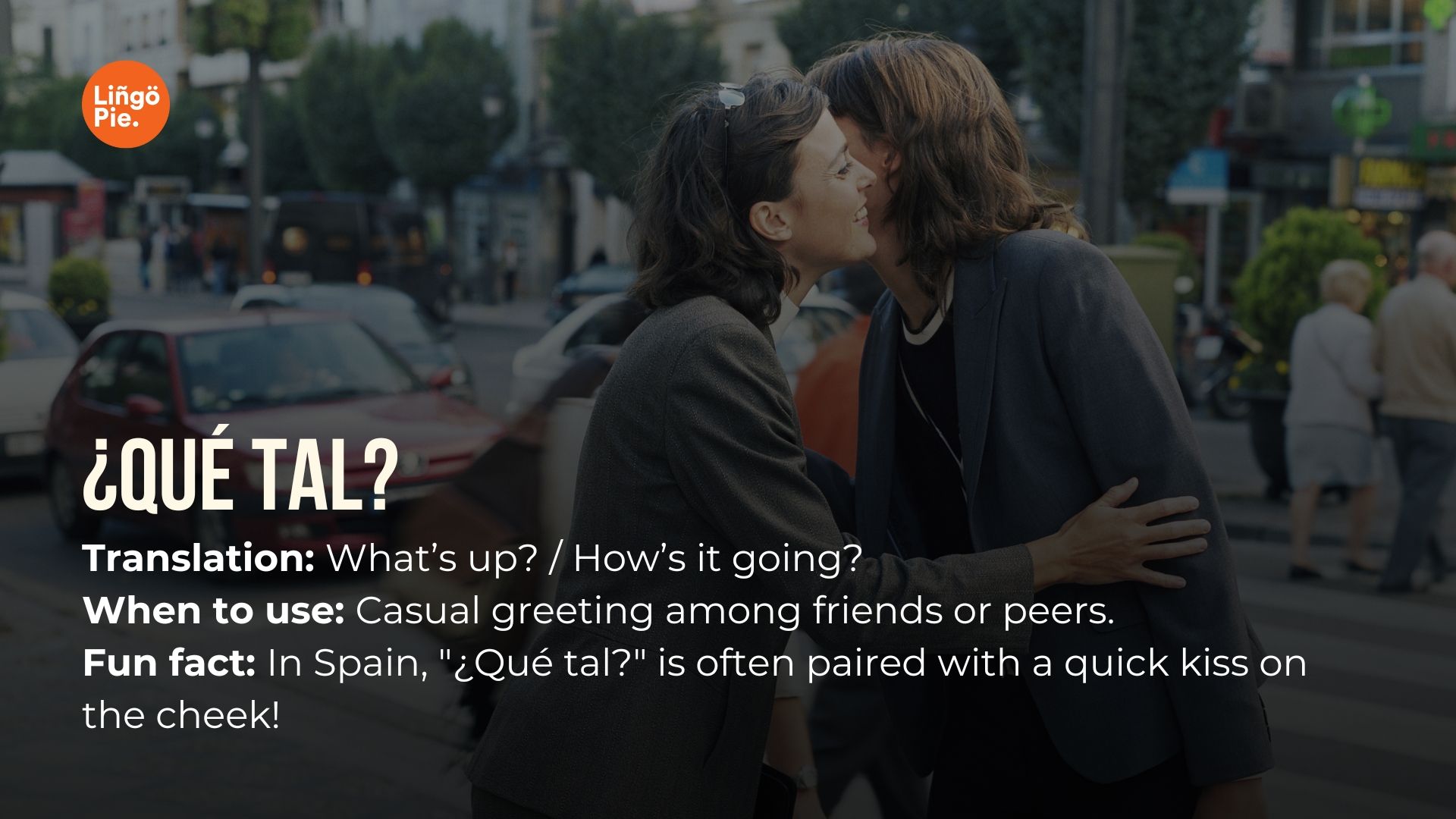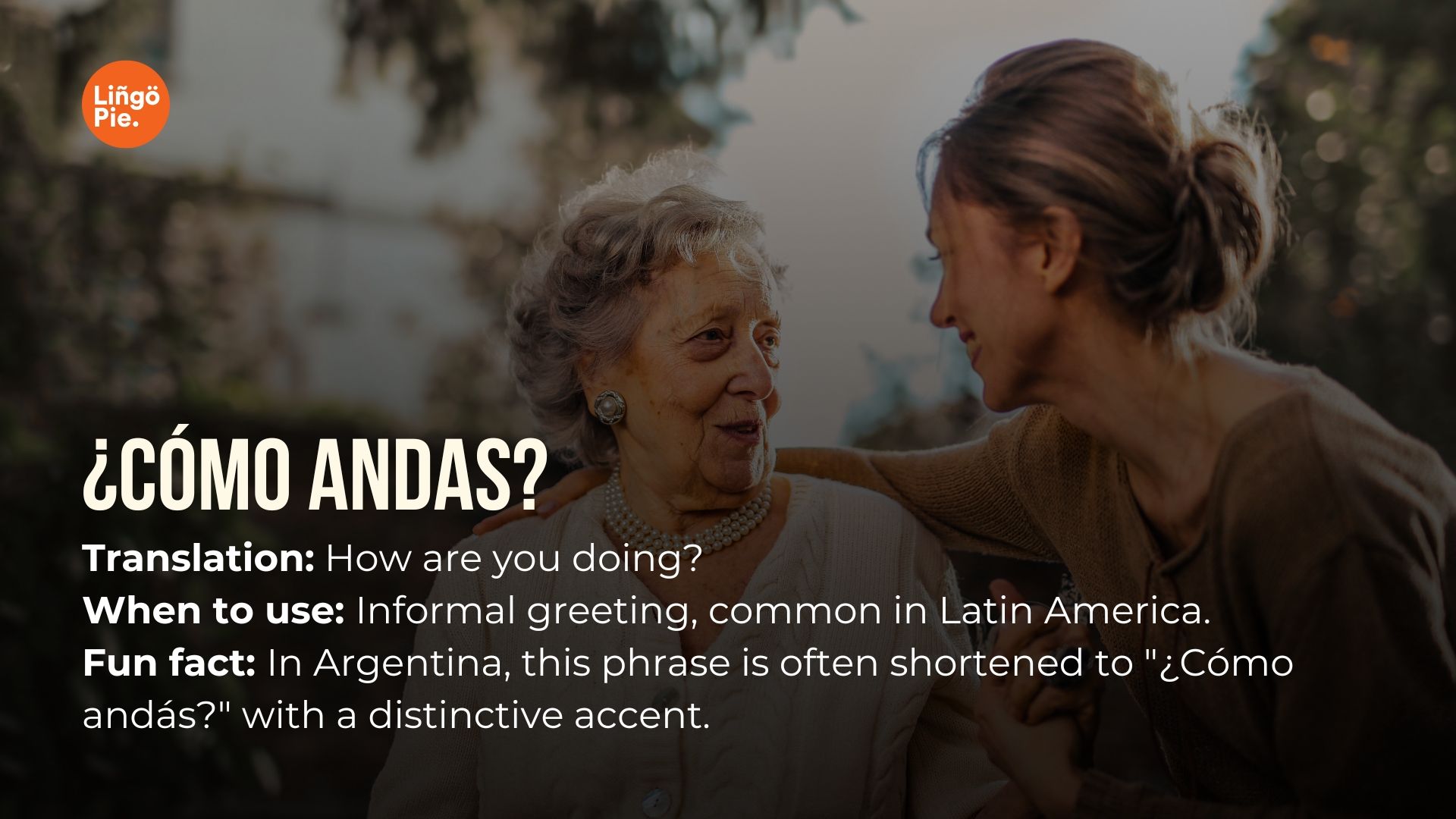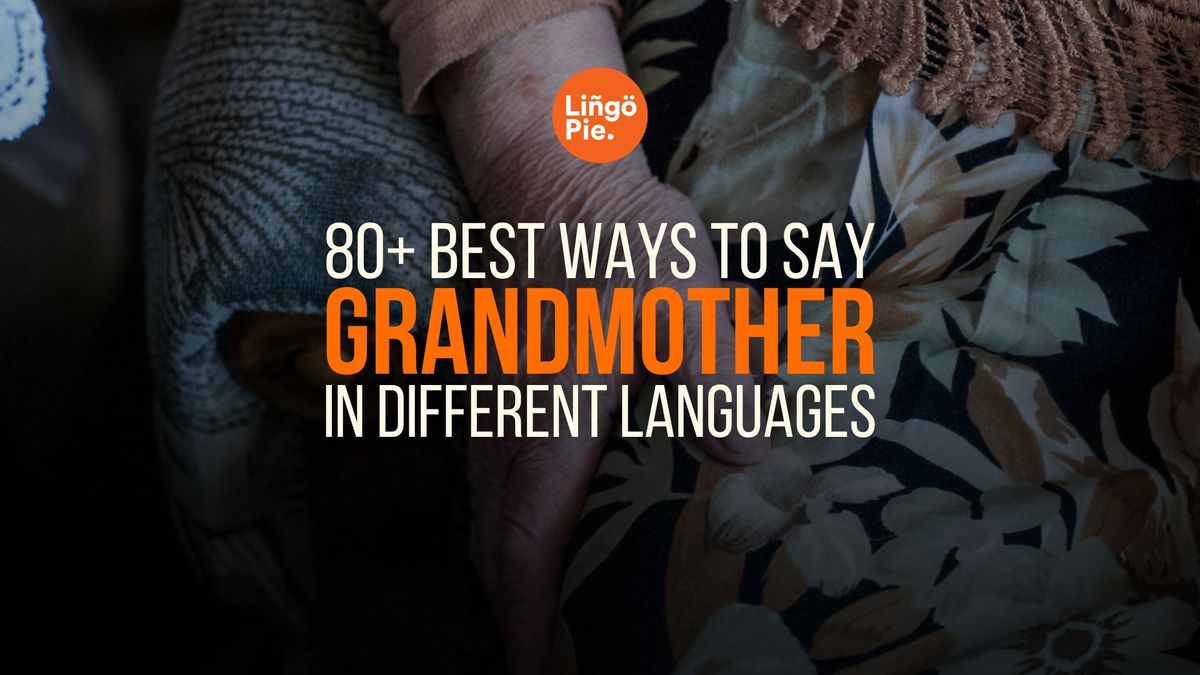Ever frozen up when a Spanish speaker greets you, only to respond with an awkward smile or a mumbled "Hola"? We've all been there. Knowing the right Spanish greetings isn't just about memorizing words – it's your key to making genuine connections in Spanish-speaking countries.
Ready to level up your Spanish? In this guide, we’ll explore 40 must-know Spanish greetings for 2024 that will take you from a confused beginner to a confident conversationalist. For more tips on mastering Spanish, check out our guide on how to learn Spanish effectively. Let’s dive in and say goodbye to awkward pauses!
“How Much?” in Spanish: A Basic Guide for Travelers and Learners
7 Practical Reasons Why Learn Spanish With Lingopie
6 Funniest Spanish Comedy Movies On Netflix To Watch

How To Greet Someone In Spanish

Greeting someone in Spanish combines two simple steps: a greeting word or phrase, followed by a friendly "how are you?" Just like "Hi, how's it going?" in English, Spanish speakers love to pair their hellos with a warm follow-up question. The basic formula is [Greeting] + ¿Qué tal? / ¿Cómo estás? / ¿Cómo te va? For example: "¡Hola! ¿Qué tal?"
| Greeting | Meaning | When to Use | Example Template |
|---|---|---|---|
| ¡Hola! | "Hello!" | Any time, any situation | "¡Hola! ¿Cómo estás?" (Hello! How are you?) |
| Buenos días | "Good morning" | Before noon | "¡Buenos días! ¿Qué tal?" (Good morning! How's it going?) |
| Buenas tardes | "Good afternoon" | Noon to sunset | "Buenas tardes, ¿cómo te va?" (Good afternoon, how's it going?) |
| Buenas noches | "Good evening/night" | After sunset | "Buenas noches, ¿cómo está usted?" (Good evening, how are you? [formal]) |
Pro Tip: Spanish speakers often drop the '¡' and '¿' in casual texting, but they're correct in formal writing.
40 Expressions to Use When Greeting in Spanish
From super casual to formal business settings, Spanish greetings come in all flavors. We've organized these 40 essential expressions into five categories to help you navigate any social situation. Each section includes exactly when and where to use these phrases, so you'll never feel out of place in a conversation.
Casual Everyday Greetings

These are your go-to phrases for friends, family, and informal situations. They're relaxed, friendly, and perfect for daily use – whether you're bumping into friends at a café or chatting with classmates.
| Spanish | English | When to Use |
|---|---|---|
| ¿Qué tal? | How's it going? | Anytime, very casual |
| ¿Qué pasa? | What's up? | Among friends |
| ¿Qué onda? | What's up? (Latin America) | Very informal, young people |
| ¿Cómo vas? | How's it going? | Casual check-in |
| ¿Qué hay? | What's new? | Casual, among friends |
| ¡Ey! | Hey! | Very casual, young people |
| ¡Buenas! | Hi there! | Casual shorthand |
| ¿Qué hubo? | What's up? (Colombia) | Casual, regional |
Time-Specific Formal Greetings
These polite expressions show respect and are essential for professional settings, speaking with elders, or in formal situations. They change depending on the time of day.
| Spanish | English | When to Use |
|---|---|---|
| Buenos días | Good morning | Before noon, formal |
| Muy buenos días | Very good morning | Extra polite, formal |
| Buenas tardes | Good afternoon | Noon to sunset, formal |
| Buenas noches | Good evening/night | After sunset, formal |
| Buen día | Good day | All day, slightly formal |
| Tenga buen día | Have a good day | Formal, when parting |
First-Time Meeting Greetings
When meeting someone new, Spanish speakers often use specific phrases to show respect and establish a connection. These expressions help you make a great first impression in both casual and professional settings.
| Spanish | English | When to Use |
|---|---|---|
| Mucho gusto | Nice to meet you | Universal, semi-formal |
| Encantado/a | Delighted (to meet you) | Formal, professional |
| Es un placer | It's a pleasure | Formal meetings |
| ¿Cómo te llamas? | What's your name? | Casual |
| ¿Cuál es su nombre? | What is your name? | Formal |
| Me llamo [name] | My name is [name] | Universal |
| Permítame presentarme | Allow me to introduce myself | Very formal |
Friendly Follow-up Questions

These phrases usually follow your initial greeting. They show interest in the other person and help keep the conversation flowing naturally.
| Spanish | English | When to Use |
|---|---|---|
| ¿Cómo estás? | How are you? | Universal, informal |
| ¿Cómo está usted? | How are you? | Formal |
| ¿Qué hay de nuevo? | What's new? | Casual |
| ¿Cómo te va? | How's it going? | Informal |
| ¿Cómo andas? | How are you doing? | Very casual |
| ¿Qué cuentas? | What's up? | Among friends |
| ¿Todo bien? | All good? | Quick check-in |
| ¿Qué me dices? | What's new with you? | Casual catch-up |
Regional Casual Greetings

These greetings vary by country but are useful to know.
| Spanish | English | Region/Use |
|---|---|---|
| ¿Qué lo qué? | What's up? | Dominican Republic |
| ¿Qué más pues? | What's up? | Colombia |
| ¿Qué bolá? | What's up? | Cuba |
| ¿Qué mostro? | What's up? | Peru |
| Che | Hey | Argentina |
Texting & Social Media Greetings
Modern Spanish has evolved to include casual digital greetings. These are perfect for WhatsApp, social media, or texting with Spanish-speaking friends.
| Spanish | English | When to Use |
|---|---|---|
| Holis | Hey! | Very casual, texting |
| Wey/Güey | Dude/Buddy (Mexican) | Very informal |
| Q tal? | Sup? | Text shorthand |
| Salu2 | Greetings (saludos) | Text shorthand |
| Qué más? | What else?/What's up? | Casual chat |
| Buenas | Hey/Hi | Short version of formal greetings |
| Ola k ase | Hey what's up (internet slang) | Very informal, joking |
Pro Tip: Remember that text speak varies significantly between Spanish-speaking countries. What's common in Mexico might be unfamiliar in Spain or Argentina.
Learn Spanish with Lingopie
If you're on the hunt for a unique, engaging, and highly effective way to learn Spanish, look no further than Lingopie. This innovative platform takes language learning to the next level by offering a unique approach that combines entertainment and education.
With Lingopie, you can immerse yourself in Spanish language learning through TV shows and movies. This method not only makes learning more enjoyable but also provides a context for the language, making it easier to understand and remember new words and expressions, including essential greetings.
As you watch, you have the ability to click on any word or phrase that appears in the subtitles. This action will provide an instant translation, allowing you to learn and understand new phrases as they are used in real-world, natural conversations. This feature is incredibly helpful for beginners and advanced learners alike, as it allows for immediate comprehension and vocabulary expansion.
Lingopie's interactive method ensures that you're not just passively absorbing information, but actively engaging with the language. This way, you're not just learning Spanish; you're living it. So, if you're ready to dive into the vibrant world of Spanish language in a way that's both fun and effective, give Lingopie a try.
Incorporating Greetings into Your Spanish Learning Routine
Incorporate these greetings into your daily routine to make them a natural part of your Spanish vocabulary. You can practice them with friends, family, or language exchange partners. You can also use them while watching Spanish TV shows or movies to understand how they are used in real-life scenarios.
Summing Up:
Starting your journey to learn Spanish with greetings is a practical and engaging approach. It not only helps you to initiate conversations but also gives you confidence in your language skills. So, start today, say "Hola" to the Spanish language, and let Lingopie guide you on your journey to fluency.
FAQs About Spanish Greetings
1. What is a typical Spanish greeting?
A typical Spanish greeting is "Hola," which means "Hello." It’s used in both formal and informal settings. Other common greetings include "Buenos días" (Good morning), "Buenas tardes" (Good afternoon), and "Buenas noches" (Good evening/night). These phrases are essential for starting conversations in Spanish-speaking countries.
2. What are the 50 most common Spanish words?
While we can’t list all 50 here, some of the most common Spanish words include:
- Hola (Hello)
- Adiós (Goodbye)
- Gracias (Thank you)
- Por favor (Please)
- Sí/No (Yes/No)
- Amigo (Friend)
- Familia (Family)
For a full list, check out our guide on essential Spanish vocabulary.
3. How do you respond to Hola in Spanish?
You can respond to "Hola" with another "Hola" or a more specific greeting like "Buenos días" (Good morning) or "¿Cómo estás?" (How are you?). If someone asks "¿Cómo estás?", you can reply with "Bien, gracias" (Good, thank you) or "Muy bien" (Very well).
4. What is a warm greeting in Spanish?
A warm greeting in Spanish could be "¡Mucho gusto!" (Nice to meet you!) or "¿Cómo te va?" (How’s it going?). These phrases are friendly and show genuine interest in the other person. For a more affectionate greeting, you might say "¡Un abrazo!" (A hug!) or "¡Bienvenido/a!" (Welcome!).
5. What is a famous Spanish greeting?
One of the most famous Spanish greetings is "¿Qué tal?" (What’s up?). It’s casual, widely used, and works in almost any situation. Another iconic greeting is "Buenos días," which is often associated with the warm, welcoming culture of Spanish-speaking countries.




![How To Become Fluent in Spanish: 5 Best Tips [2025]](/blog/content/images/2023/10/444DE53E-3543-4F83-8DA7-E5BE31BAD1AA.png)

![30+ Modern English Slang Terms For Money [Guide]](/blog/content/images/size/w300/2025/06/Slang-term-for-money.jpg)
![5 Official Spanish Language Tests To Show Your Proficiency Level [Guide]](/blog/content/images/size/w300/2025/06/Spanish-Language-Tests.jpg)

![Why Memorizing Spanish Words Won’t Make You Fluent [Tips]](/blog/content/images/size/w300/2025/06/how-to-practice-spanish-vocabulary.jpg)